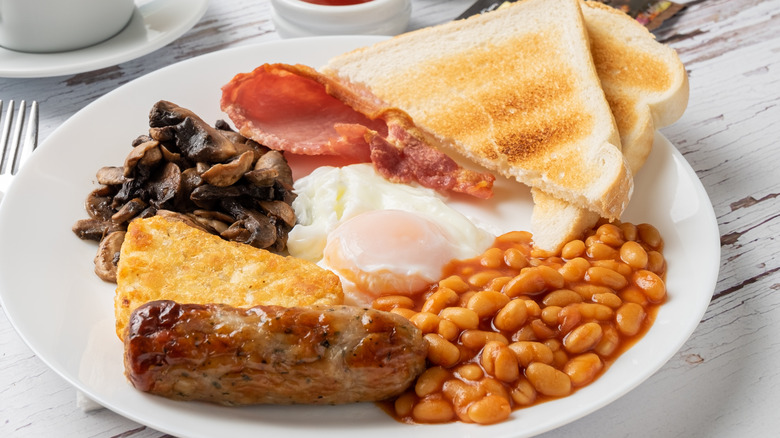Full English Vs. Full Irish Breakfast: What's The Difference?
If you haven't eaten a full English or Irish breakfast, have you ever really, truly eaten it? You may think the Denny's Grand Slam is the crown jewel of morning eating, but it's got nothing on the traditional breakfasts devoured across the pond. While Spaniards and Italians may be content starting their day with toast and coffee, you can expect much heartier fare in the British Isles.
English breakfast is a fairly old tradition, dating back to the English gentry of the 14th and 15th centuries. Made up of nobility, landowners, and the "genteel," the gentry considered themselves keepers of British pastoral tradition, and part of that tradition included breakfast feasts. Often served before a hunt, these early meat-heavy breakfasts included different types of fish and fowl as well as offal like tongue and kidney.
The morning feast in England eventually expanded to fuel workers without class distinction and traveled to other parts of the kingdom, including Ireland. As always, traditions take on local flavors as they are adopted in new areas, and Ireland's full breakfast has some unique, delicious twists.
What is a full English breakfast?
Today's full English breakfast looks very little like the 14th-century original, usually lacking the game meats and encompassing more variety. The U.K.'s contemporary morning meal includes bacon, eggs, sausage, baked beans, tomatoes, and mushrooms. You might also find bubble and squeak on the table, a dish that typically combines potatoes and cabbage, although other vegetables can be used.
Meats served for an English breakfast are worth noting. English bacon is not the same as American bacon; you'll find it to be leaner and not smoked. Known as back bacon, it comes from the leaner loin along with the belly meat for a delicious combination on the plate. You'll find a wide array of sausages to choose from, including mild pork sausages to dark and hearty blood sausages and interesting regional variations. No matter what combination you choose, an English full breakfast is sure to fortify you for the day ahead.
What is a full Irish breakfast?
While a full Irish breakfast doesn't include a pint of Guinness, it does have all the savory staples that breakfast aficionados love, including eggs and meat. Button mushrooms cooked in Irish butter and cooked tomato halves are included in the full Irish. Brown soda bread or toasted pan bread, which is bread made in a tin, rounds out the breakfast. Notably missing in most Irish breakfasts are the baked beans and potatoes you'll find in an English breakfast.
Irish breakfast is also called fry-up and can include black or white sausages, also referred to as pudding. Do not confuse these with American pudding! White pudding mixes pork or beef suet with oatmeal or barley-based along with fragrant seasoning often in sausage making, like onions and coriander. Black pudding, however, is a blood sausage. Tradition dictates that white or black pudding is on the plate for breakfast, but not both!
Whether you prefer baked beans or sausages, Irish soda bread, or bubble and squeak, there's much to love about English and Irish full breakfasts. The similarities are greater than the differences, and the English and Irish love a strong cup of tea with these hearty meals. One thing to know is that you can also find these traditional breakfasts at all times of the day, so if you happen to be a light morning eater, no worries, you can indulge later in the day as well.


